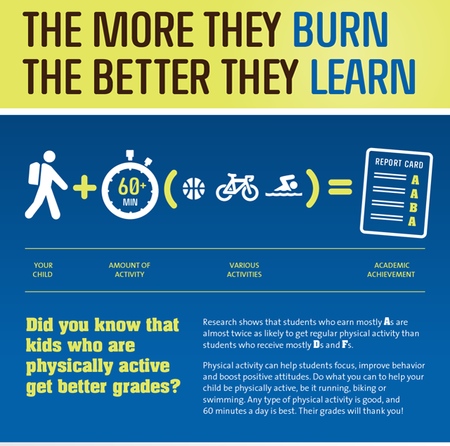Learning and Physical Activity
Every day we hear how we, and our children, need to be more physically active. The Canadian Physical Activity Guide (CPAC) suggests that children need to accumulate at least 60 minutes of activity each day. They should also participate in vigorous activity and strengthening activities at least three days per week each. (http://www.csep.ca/CMFiles/Guidelines/CSEP-InfoSheets-child-ENG.pdf0).
This can help children with improved health, better scholastic achievement, better fitness, feel happier, maintain a healthy weight, improve self-confidence, and learn new skills.
The trick is how to actually incorporate learning and physical activity. Here are a few suggestions:
1. Memorization (ie, memorizing times tables or spelling words):
a. jump rope
b. bounce a ball between you
c. draw a table grid in sidewalk chalk and jump around
2. Social Studies and English
a. create a skit playing the roles of the major players
b. make puppets and act it out
c. create a full-sized ‘board game’ to learn and test facts
d. body spelling – one child per letter
e. language lights – consonants, vowels, verbs, nouns – with a cut out of a stop light – red is stop, yellow is jog on the spot, and green is do an activity that is assigned to each type of activity (touching toes, jumping jacks, hopping)
3. Science
a. take walks and experience the science of nature
Other Ideas Include:
· preparing dinner (fractions, measures, etc.)
· housekeeping (measuring, proportion, area, perimeter)
· laundry (colours, classification, statistics, probability, fractions, percentage)
· gardening
· use walks to learn different things such as colours, vocabulary words in any language
· scavenger hunts with problems written on the hints that need to be correct to win
· prepare different multiple choice questions and have children shoot bean bags/balls at the correct answer
· walking tour of Canada
· different ‘walk around’ games that incorporate different types of movement to learn different types of facts https://education.alberta.ca/media/318482/dpa8.pdf – Appendix 8/9
· memory – put facts/matching words, equations and answers, etc. on 8.5 * 11 sheets of paper and have them jump, hop, etc. around to match them up.
· use a similar idea for trivia by putting the cards in a pile at the other end of the room/drive
· T/F Simon Says – if the fact is true – do some type of activity
The ideas are limited only by yours and your children’s imaginations. Don’t get overwhelmed with the amount of time you need to spend. Several 10-15 minute sessions are just as good as a long one. Do whatever you both enjoy. Participate with them and you will benefit as well. You will get exercise, have fun, and spend a great time bonding with each other.
Tutoring… With A Twist tutors not only support learners in every subject area; we also support them with a predetermined life-skill. By helping learners develop the tools they need to succeed in the classroom, we also help them develop the tools to succeed in life.

